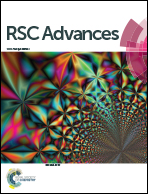Analysis of electron transfer dynamics in mixed community electroactive microbial biofilms†
Abstract
Mixed community electroactive organisms form multi-layered biofilms that are able to produce current densities comparable to those of pure Geobacter sulfurreducens, an extensively studied metal-reducing organism. The long-range electron transfer (ET) inside the biofilms and at the biofilm/electrode interface was proven to be promoted by a network of outer membrane cytochromes (OMCs). In the present work, we investigate the electron transfer process in mixed community biofilms grown on Indium Tin Oxide (ITO) electrodes by combining electrochemical measurements with Confocal Resonance Raman Microscopy (CRRM) under potentiostatic control and during chronoamperometry (CA). This approach allowed direct comparison of the heterogeneous redox process at the biofilm/electrode interface with the long-range OMCs-mediated ET inside the bulk biofilm. Our work shows that: (i) during substrate oxidation, all OMCs are in the reduced state at any distance from the electrode, and no concentration gradient of oxidized OMCs is observed; (ii) the rate constant for the long-range, homogeneous ET (k0hom) is 0.028 s−1, which is considerably lower than that predicted by others under the hypothesis that homogeneous ET is promoted by OMCs alone, and may thus indicate the contribution of alternative fast electron transfer processes; (iii) the metabolic respiration rate is much faster compared to both homogeneous and heterogeneous ET, which have similar rate constants. All in all, our results suggest that differences exist in electron transfer mechanisms between mixed community and G. sulfurreducens electroactive biofilms.


 Please wait while we load your content...
Please wait while we load your content...